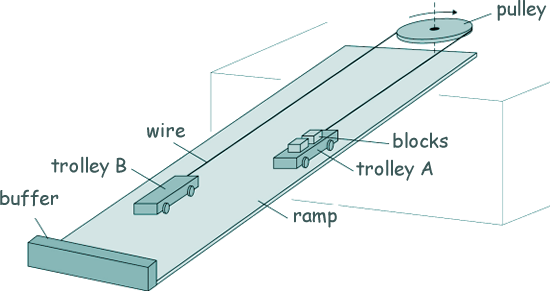Momentum Questions Q7. The diagram below shows a model of a system being designed to move concrete building blocks from an upper to a lower level.
The model consists of two identical trolleys of mass M on a ramp which is at 35° to the horizontal. The trolleys are connected by a wire that passes around a pulley of negligible mass at the top of the ramp. Two concrete blocks each of mass 'm' are loaded onto trolley A at the top of the ramp. The trolley is released and accelerates to the bottom of the ramp where it is stopped by a flexible buffer. The blocks are unloaded from trolley A, and two blocks are loaded onto trolley B (that is now at the top of the ramp). The trolleys are released and the process is repeated. (a) Here is a diagram showing the side view of trolley A when it is moving down the ramp:
The tension in the wire when the trolleys are moving is T. Draw and label arrows on the side view diagram above to represent the magnitudes and directions of any forces and components of forces that act on trolley A parallel to the ramp as it travels down the ramp. [1 mark] (b) Assuming that no friction acts at the axle of the pulley or at the axles of the trolleys and that air resistance is negligible. Show that the acceleration 'a' of trolley B along the ramp is given by the equation:
[2 marks] (c) Compare the momentum of loaded trolley A as it moves downwards with the momentum of loaded trolley B. [2 marks] (d) In practice, for safety reasons there is a friction brake in the pulley that provides a resistive force to reduce the acceleration to 25% of the maximum possible acceleration. The distance travelled for each journey down the ramp is 9.0 m. The following data apply to the arrangement:
Calculate the number of seconds it takes for a loaded trolley to travel down the ramp. [3 marks] (e) It takes 12s to remove the blocks from the lower trolley and reload the upper trolley. Calculate the number of blocks that can be transferred to the lower level in 30 minutes. [2 marks] (10 Marks Total) |
Follow me...
|







